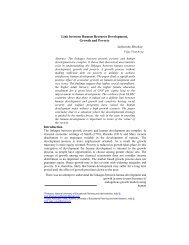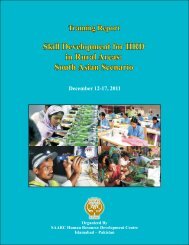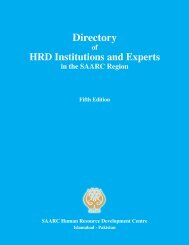Training Report: Millennium Development Goals in the SAARC Region
Training Report: Millennium Development Goals in the SAARC Region
Training Report: Millennium Development Goals in the SAARC Region
Create successful ePaper yourself
Turn your PDF publications into a flip-book with our unique Google optimized e-Paper software.
Work<strong>in</strong>g Sessions<br />
Goal 2 ‘Achieve Universal Primary Education’ focuses on three <strong>in</strong>dicators. i) Net enrolment at primary level<br />
rema<strong>in</strong>ed below 60% until 2008-09; although, <strong>the</strong>re has been marg<strong>in</strong>al improvement <strong>in</strong> it over time, <strong>the</strong> MDG<br />
target of achiev<strong>in</strong>g 100% net enrolment ratio by 2015 requires an <strong>in</strong>crease of 43 percentage po<strong>in</strong>t <strong>in</strong> <strong>the</strong> next<br />
five years. ii) The completion/survival rate of students enrolled <strong>in</strong> primary schools also present a dismal<br />
scenario that implies that almost half of <strong>the</strong> students enrolled <strong>in</strong> primary schools do not complete <strong>the</strong>ir<br />
education; <strong>the</strong> <strong>in</strong>terim target for 2009-10 was set at 80% and could not be achieved. iii) Pakistan’s literacy rate<br />
rema<strong>in</strong>s considerably short of <strong>the</strong> MDG target of 88% by 2015, although it has marg<strong>in</strong>ally improved to 57%<br />
by 2008-09.<br />
With regard to <strong>the</strong> four <strong>in</strong>dicators for Goal-3, ‘Promote Gender Equality and Women’s Empowerment’ <strong>the</strong><br />
status of Pakistan is: i) Pakistan has made steady though slow progress with regard to <strong>the</strong> Gender Parity Index<br />
(GPI) for primary and secondary education. Despite <strong>the</strong> fact that Pakistan has missed <strong>the</strong> MDG target of<br />
gender parity <strong>in</strong> primary and secondary education <strong>in</strong> 2005, with <strong>the</strong> current pace, <strong>the</strong> MDG target of gender<br />
parity is likely to be unachievable by 2015. ii) Youth literacy GPI improved dur<strong>in</strong>g 2004-09. With <strong>the</strong> exist<strong>in</strong>g<br />
pace, <strong>the</strong> MDG target of 1.00 by 2015 is likely to be unachievable. iii) Women’s share <strong>in</strong> wage employment <strong>in</strong><br />
<strong>the</strong> non-agricultural sector has <strong>in</strong>creased but Pakistan is mak<strong>in</strong>g slow progress towards achiev<strong>in</strong>g <strong>the</strong> target.<br />
iv) With regard to number of women seats <strong>in</strong> <strong>the</strong> national parliament, Pakistan has shown substantial<br />
improvement over <strong>the</strong> years. The proportion of seats <strong>in</strong> <strong>the</strong> present National Assembly is among <strong>the</strong> highest <strong>in</strong><br />
<strong>the</strong> world.<br />
Pakistan’s status on Goal 4 ‘Reduce Child Mortality’ shows that out of six <strong>in</strong>dicators, Pakistan’s performance<br />
<strong>in</strong> achiev<strong>in</strong>g <strong>the</strong> desired MDG targets by 2015 is unsatisfactory particularly <strong>in</strong> case <strong>the</strong> first two <strong>in</strong>dicators i.e.<br />
<strong>the</strong> under-five mortality rate and <strong>in</strong>fant mortality rate. Though, Pakistan has managed to lower <strong>the</strong> under-five<br />
mortality rate, <strong>the</strong>re is still a need to reduce it by 42 percentage po<strong>in</strong>ts by 2015, a high improbable outcome.<br />
The target for 2015 for <strong>the</strong> proportion of under-five years suffer<strong>in</strong>g from diarrhoea was achieved ahead of<br />
time. Similarly, <strong>the</strong> coverage of households Lady Health Workers (LHW) <strong>in</strong>creased from 38% <strong>in</strong> 2001-02 to<br />
83% <strong>in</strong> 2008-09 <strong>in</strong> <strong>the</strong> first n<strong>in</strong>e years of <strong>the</strong> MDGs; hence, <strong>the</strong> atta<strong>in</strong>ment of 100% coverage by 2015 seems to<br />
be on track.<br />
In terms of <strong>the</strong> first <strong>in</strong>dicator of Goal 5 ‘<strong>the</strong> Maternal Mortality Ratio’, Pakistan has a considerable distance to<br />
go to meet <strong>the</strong> MDG targets by 2015. For <strong>the</strong> maternal mortality ratio, <strong>the</strong> MDG target for 2015 still requires<br />
almost a halv<strong>in</strong>g of <strong>the</strong> ratio. The 2015 target for skilled birth attendants is still more than twice of <strong>the</strong><br />
proportion achieved <strong>in</strong> 2008-09. A third <strong>in</strong>dicator relat<strong>in</strong>g antenatal care also shows low progress. In terms of<br />
family plann<strong>in</strong>g <strong>in</strong>dicators, <strong>the</strong> contraceptive prevalence rate is considerably short of <strong>the</strong> 2015 MDG target.<br />
Goal 6 ‘Combat HIV/AIDS, Malaria and O<strong>the</strong>r Diseases’, covers five <strong>in</strong>dicators. Recent trend shows that<br />
HIV/AIDS spread is <strong>in</strong>creas<strong>in</strong>g; however, Pakistan is still classified as a low prevalence country. The<br />
government is giv<strong>in</strong>g special attention to <strong>the</strong> situation and with commitment shown to this disease it seems<br />
possible that Pakistan will achieve <strong>the</strong> target by 2015. The percentage of TB cases detected and cured under<br />
DOTS has <strong>in</strong>creased from 79% <strong>in</strong> 2001-02 to 85% <strong>in</strong> 2008-09 and <strong>the</strong> MDG target has been met before time.<br />
Malaria related issues need attentions as <strong>the</strong> proportion of population <strong>in</strong> malaria risk areas us<strong>in</strong>g effective<br />
malaria prevention treatment and measure has <strong>in</strong>creased slightly by ten po<strong>in</strong>ts (from 20to 30) dur<strong>in</strong>g 2001 to<br />
2009.<br />
Pakistan’s status on Goal 7 ‘Ensure Environment Susta<strong>in</strong>ability’ shows that <strong>the</strong> land area under forest cover<br />
has marg<strong>in</strong>ally <strong>in</strong>creased from 4.9% <strong>in</strong> 2004-05 to 5.02% <strong>in</strong> 2008-09. Pakistan has become one of <strong>the</strong> largest<br />
users of Compressed Natural Gas (CNG) <strong>in</strong> <strong>the</strong> world and <strong>the</strong> MDG target for this <strong>in</strong>dicator has already been<br />
achieved. Water supply coverage <strong>in</strong>creased from 53% <strong>in</strong> 1990 to 65% <strong>in</strong> 2008-09; however, it still has a long<br />
way to go <strong>in</strong> reach<strong>in</strong>g <strong>the</strong> MDG target pf 93% by 2015. The sanitation coverage <strong>in</strong> <strong>the</strong> country has <strong>in</strong>creased<br />
from 30% <strong>in</strong> 1990 to 63% <strong>in</strong> 2008-09 accord<strong>in</strong>g to <strong>the</strong> PSLM survey 2008-09. However, it is still a long way to<br />
go <strong>in</strong> reach<strong>in</strong>g <strong>the</strong> MDG target of 90% by 2015.<br />
Pakistan’s location, both <strong>in</strong> terms of geography and <strong>in</strong> terms of development has become and can rema<strong>in</strong> a<br />
focal po<strong>in</strong>t requir<strong>in</strong>g help and assistance to achieve all seven of its MDGs by means of <strong>the</strong> Goal 8, which<br />
16
















